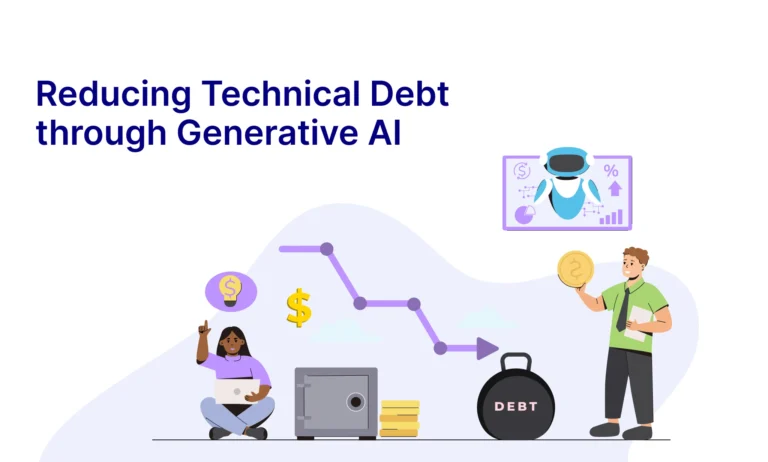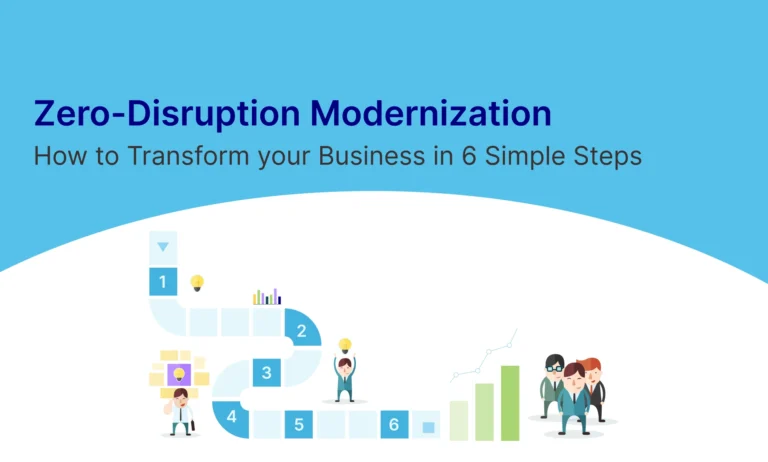Table of Contents
Agility and innovation are more than just buzzwords in today’s fiercely competitive business landscape—they’re essential for survival. With markets evolving rapidly and customer expectations soaring, businesses must adapt quickly to stay ahead of the curve.
Imagine a company stuck with outdated systems: slow, insecure, and incompatible with modern tech. This hampers innovation and market responsiveness. So, driven by the need for agility, many IT organizations are prioritizing legacy application modernisation efforts.
With legacy modernisation, businesses can revamp their systems to boost performance and security. This allows them to innovate and compete effectively. For example, consider a retail company that decides to modernise its e-commerce platform. By migrating from a monolithic architecture to a microservices-based approach, they can scale their platform more efficiently, introduce new features faster, and provide a better user experience for their customers.
Yet, IT infrastructure modernisation isn’t without challenges. It demands careful planning, tech expertise, and consideration of various factors like data migration and user training for a seamless transition.
So, how and where do you start legacy application modernisation?
Let’s have a look!
The Need for Business Agility and Innovation
Businesses today spend around 70-80% of their IT budget on old-fashioned legacy systems. Surprisingly, only a small 16% is set aside for sparking innovation and the process of product development.
Even more concerning is that this tiny innovation budget is working at just a quarter of its full potential, all because of the challenges of inflexible legacy systems.
Business agility means a company’s ability to quickly adapt to changes in the market, both inside and outside. This agility is essential for businesses to stay competitive and successful, especially in fast-changing environments.
Being agile helps companies adjust their plans, processes, and activities quickly to meet changing customer needs and market trends. This flexibility lets companies grab opportunities as they arrive, keeping them ahead of their rivals. Also, agile businesses can handle uncertainties and problems better, cutting risks and boosting their resilience.
However, traditional businesses often struggle to stay agile. Old systems and processes can slow them down, making it challenging to react quickly to changes. Rigid structures and rules also block new ideas and slow decision-making.
But what if businesses could spend half their budget on legacy modernisation and use all their productivity? Fortunately, application modernisation services can make it happen.
Application Modernisation: A Catalyst for Change
Application modernisation involves updating and upgrading existing software applications and migrating to modern technologies, architectures, and deployment methods. This process enhances the performance, efficiency, and agility of applications while reducing technical debt and operational costs.
Leading enterprises have begun legacy application modernisation (often called adopting cloud-native solutions), like taking a “cloud-first” approach. This shift has significantly accelerated the deployment pace for these organizations. According to Enterprise Strategy Group (ESG), 90% of enterprises found cloud-native applications deploy faster, with 30% experiencing notably faster results.
Approaches to Legacy Application Modernization
The journey of legacy application modernisation can take various paths, depending on the organization’s goals, resources, and technology landscape:
- Modernise: Retain existing on-premise applications but migrate to more modern application and infrastructure architectures.
- Refactor and shift: Use cloud-native frameworks to redesign existing applications and further deploy them in off-premises cloud environments for improved scalability and flexibility.
- Lift and shift: Migrate current on-premises applications to cloud platforms or off-premise environments. But make minimal alterations to the application code and business logic to ensure continuity and cost-effectiveness.
- Repurchase and shift: Replace all current on-premises applications with SaaS (Software as a Service) or off-premises versions by leveraging third-party solutions for enhanced functionality and scalability.
- Retain: Keep current applications unchanged but integrate them with modern technologies and platforms to extend their lifespan and functionality.
| Improve Your User Experience with Our Expertise in Crafting State-of-the-Art Smart Products for Your Digital Modernisation Journey <Explore our services> |
Technology Trends In Application Modernisation Strategies
Here are some key technology trends driving application modernisation strategies:
- Cloud applications: Embracing cloud technology allows seamless data sharing and lets teams collaborate effectively across various tools and locations. Cloud solutions offer scalability, cost-efficiency, and agility to adapt to changing customer needs.
- Containers: Containers streamline application deployment and management in cloud environments to ensure accessibility, efficiency, and security as applications transition between different platforms.
- Microservices: Modern applications adopt a modular approach with microservices, allowing organizations to select tailored solutions for specific requirements. Microservices, interconnected through APIs, enable creating flexible and customizable solutions.
- Automation: Automating repetitive tasks enhances workflow efficiency and empowers teams to focus on value-adding tasks. Automation drives productivity gains and accelerates the software development lifecycle.
- DevOps: DevOps practices foster collaboration between development and operations teams and drive rapid delivery of high-quality software. By leveraging analytics and monitoring, organizations can make data-driven decisions to drive continuous improvement. 82% of businesses consider agile DevOps a driving force behind their application modernisation services.
- APIs: APIs are crucial in integrating disparate systems and enabling seamless communication between applications. APIs facilitate the development of interconnected ecosystems, driving innovation and interoperability.
- Digital adoption platforms: Digital adoption platforms provide users with guidance and support, enhance user experience, and drive adoption rates. These platforms empower users to navigate complex systems effectively, reducing the learning curve and increasing productivity.
- Data warehouses: Modern data warehouses ensure efficient storage, management, and protection of the vast data applications generate. By centralizing data and ensuring accessibility, organizations can derive valuable insights that drive strategic decision-making.
How to Get Started with Legacy Modernization?
Here’s a quick 7-step strategy to modernise legacy applications effectively:
- Assess and analyze: Conduct a comprehensive evaluation of existing systems, examining their architecture, functionality, and integration points. This assessment provides insights into the applications’ current state and identifies areas that require modernisation to improve user experience and streamline processes.
- Define objectives: Clearly articulate the goals of legacy modernisation, such as enhancing performance, optimizing user experience, and reducing maintenance costs. These objectives guide modernisation principles, ensuring alignment with business priorities and goals.
- Application audit: Conduct a thorough audit of the current application portfolio to identify legacy components, dependencies, and areas for improvement. This audit helps prioritize modernisation efforts and allocate resources effectively.
- Create a roadmap: Develop a detailed roadmap outlining the modernisation process, including timelines, milestones, and resource allocation. This roadmap provides a clear path forward for legacy modernisation, ensures alignment with business objectives, and facilitates effective project management.
- Technology selection: Based on business requirements and objectives, choose appropriate modernisation technologies, such as cloud migration, containerization, or microservices architecture. The right technologies are crucial for achieving desired outcomes and ensuring compatibility with existing systems.
- Implementation: Execute modernisation initiatives incrementally, starting with low-risk components and gradually migrating critical functionalities. This phased approach minimizes disruption to operations and allows for continuous improvement throughout the modernisation process.
- Testing and validation: Thoroughly test modernised applications to ensure functionality, security, and performance meet desired standards. Testing and validation are essential to the modernisation process to identify and address any issues or discrepancies before deployment.
Wrapping Up
Application modernisation is imperative for businesses seeking enhanced ROI, developer productivity, and customer experiences. It involves strategically transforming monolithic applications into cloud-native architectures by restructuring existing systems or building new ones.
In this regard, custom software development services offer tailored solutions to navigate market dynamics and innovate effectively. Through tailored application development and digital product engineering services, businesses can gain the agility to adapt swiftly to market dynamics while paying attention to improving user experience. Moreover, these services enable enterprises to manage legacy systems efficiently, minimize technical debt, and foster a culture of innovation.
At Byteridge, we stand ready to be your catalyst for innovation. With a comprehensive suite of services spanning product conceptualization, software development, verification, and user experience definition, we can be your partner in achieving digital excellence.
Partner with us to drive transformative change and achieve enduring success in this digital competition.
| Ready to revolutionize your IT infrastructure? Schedule a consultation today and innovate together for a brighter digital future. <Connect with Our Expert> |
References:
https://whatfix.com/blog/legacy-application-modernisation/
https://d2ms8rpfqc4h24.cloudfront.net/enterprise_guide_to_continuous_application_modernisation_0ee06c8cd0.pdf
https://www.cdw.com/content/cdw/en/articles/software/increase-agility-and-innovation-through-application-modernisation.html
https://www.infosys.com/services/application-modernisation/documents/increase-business-agility.pdf
https://www.linkedin.com/pulse/importance-application-modernisation-business
https://www.ibm.com/downloads/cas/E65RZ5JV








